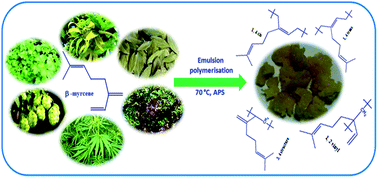Synthesis, characterization and properties of a bio-based elastomer: polymyrcene†
Abstract
An environmentally benign emulsion polymerisation technique was exploited to prepare a bio based polymer from a naturally occurring monoterpene, β-myrcene. The structure of the polymer was ascertained by spectroscopic measurements. Density functional theory was employed to determine the ground state optimised structure of β-myrcene. The persulfate initiated polymyrcene possesses 3,4 and 1,2 vinyl defects along with 1,4 microstructures, whereas the redox analogue contains solely 1,4 addition products. The synthesised polymer displayed a substantially high molecular weight (upto 92 860 Da for persulfate polymyrcene) and subzero (−73 °C) glass transition temperature along with shear thinning behaviour within the experimental conditions, thereby rendering itself as a promising entrant in the domain of bio-based elastomers.


 Please wait while we load your content...
Please wait while we load your content...